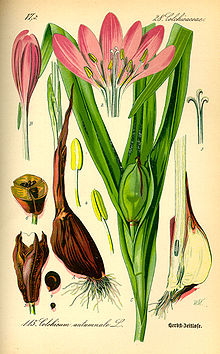Meadow saffron
| Colchicum autumnale | |
|---|---|
 |
|
| Scientific classification | |
| Kingdom: | Plantae |
| (unranked): | Angiosperms |
| (unranked): | Monocots |
| Order: | Liliales |
| Family: | Colchicaceae |
| Genus: | Colchicum |
| Species: | C. autumnale |
| Binomial name | |
|
Colchicum autumnale L. |
|
| Synonyms | |
|
|
Colchicum autumnale, commonly known as autumn crocus, meadow saffron or naked lady, is an autumn-blooming flowering plant that resembles the true crocuses, but is a member of the Colchicaceae plant family, unlike the true crocuses which belong to the Iridaceae family. The name "naked lady" comes from the fact that the flowers emerge from the ground long after the leaves have died back.
The species is commonly cultivated as an ornamental in temperate areas, in spite of its toxicity.
Colchicum autumnale is the only species of its genus native to the Great Britain and Ireland, with notable populations under the stewardship of the County Wildlife Trusts. It also occurs across mainland Europe from Portugal to Ukraine, and is reportedly naturalized in Denmark, Sweden, European Russia, the Baltic states and New Zealand.
The bulb-like corms of Colchicum autumnale contain colchicine, a useful drug with a narrow therapeutic index. Colchicine is approved by the US FDA for the treatment of gout and familial Mediterranean fever. Colchicine is also used in plant breeding to produce polyploid strains.
Colchicum plants are deadly poisonous due to their colchicine content, and have been mistaken by foragers for ramsons, which they vaguely resemble. The symptoms of colchicine poisoning resemble those of arsenic, and no antidote is known.
...
Wikipedia
